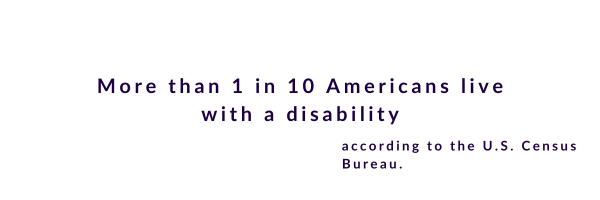More than 1 in 10 Americans live with a disability, according to the U.S. Census Bureau.
And while people usually think of disabilities in the physical form, many Americans live with “invisible” disabilities. “Unseen” or “invisible” disabilities have symptoms and impairments that are non-apparent, such as chronic pain, learning disabilities, or mental health conditions.
All employees deserve to feel supported in the workplace, despite any adversities they may face. Learn how HR professionals and companies can support employees living with disabilities and provide resources that can facilitate their overall success.
1. Cultivate a work culture that allows employees living with disabilities to show up authentically
Focusing on equity and inclusion can help create a work culture and environment that not only attracts top talent but allows employees to show up as their full selves.
Recruiters and talent acquisition teams are increasingly focusing on recruiting diverse talent — however, it’s important to build a work environment where employees with disabilities feel included. Creating an inclusive work environment is key to both attracting talent but also retaining talent. Data from the U.S. Department of Labor found that organizations that diversified to include employees with disabilities report a 72 percent increase in employee productivity.
Whether it be live transcriptions during virtual meetings, using larger text in PowerPoints, or providing a private wellness room, companies are going beyond the minimum to make the workplace more accessible. These small touches and accommodations can make a difference to top talent in the job market.
2. Create an employee resource group supporting accessibility and employees living with disabilities.
Employee resource groups are communities within companies that connect employees of a shared identity or interest identity, such as race/ethnicity or gender. Employee resource groups have been around for decades — in 1970, the first employee resource group was created by a group of Black employees at Xerox. Today, companies have evolved to support employee resource groups for employees living with disabilities, whether “visible” or “invisible.”
Navigating the work environment with a disability isn’t easy, especially when it comes to self-advocacy and asking for accommodations. Having an employee resource group focused on accessibility and employees living with disabilities can help create a community and attract top diverse talent.
3. Offer financial wellness education that is accessible and easy to use.
Americans living with disabilities are more likely to face financial hardship, compared to Americans without disabilities. Per the U.S. Census Bureau, employees with a disability make about $28,000 on average, compared to $40,000 for employees without a disability. This means that employees living with disabilities are more likely to face financial hardship as they have less disposable income, or money left over after monthly expenses.
Offering a financial wellness program can help improve employees’ financial wellness and knowledge. For instance, many Americans living with disabilities are less likely to have a bank account than Americans without disabilities.
A robust, accessible financial wellness program should be personalized to individual employee’s needs — some employees may need help getting their first credit card, while others may be seasoned investors looking to expand their portfolio. Regardless of one’s level of financial knowledge, all employees can benefit from access to financial wellness benefits and resources.
4. Allow employees to use their health insurance benefits starting day 1
Some companies require a waiting period before employees are allowed to use their health benefits; however, for employees living with disabilities, waiting 60 or 90 days may be too long and only exacerbate their symptoms.
For instance, employees suffering from a chronic condition or taking multiple medications may not be able to afford to go a month or two without health insurance. This may worsen their conditions.
Allowing employees to use their health insurance benefits starting day 1 can demonstrate a corporate commitment to inclusivity — moreover, this can help set employers apart from the competition when attracting top talent.
To learn more about Best Money Moves Financial Wellness Platform, let’s schedule a call. Contact us and we’ll reach out to you soon.

